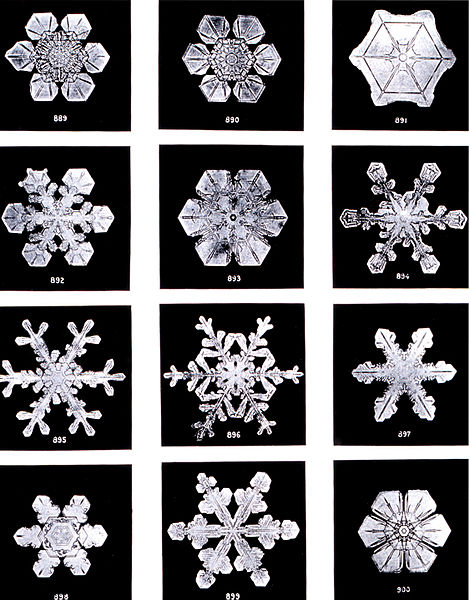
[ home ]
My students are like snowflakes... they are all different, but there are certain common factors.
All have left school with a sense of failure in Mathematics. All need to gain the coveted GCSE pass at grade C. English is not the first language of some of the students, but all of them need to become familiar with the specialised vocabulary used in mathematics to describe chance.
This page describes a simple activity to find out how GCSE students on a part-time adult education course think about chance and probability. The activity involves posting sticky notes that describe an event, such as 'it will snow today' or 'roll a 5 on a dice' into the right category on a copy of the probability scale on the wall of the classroom. Some teachers hang a washing line across the room and students have to peg the statements into the right location. I put the activity in the context of the rest of the lesson designed to cover most of the probability content in GCSE Foundation Maths.

I like to capitalise on contingent events like the weather or happy news items, in a smaller scale way to Francis Su's Math Fun Facts.
It was snowing lightly on the morning of the lesson, so I started off with the Wilson Bentley image shown above imported into the interactive whiteboard software we use in College. And I explained about how snow flakes grow while falling so the crystals are all different, and how there is an underlying six fold rotational symmetry and three mirror planes. Using the interactive whiteboard software to draw the mirror planes on one of the snow flakes got the idea across. As a result of this 3 minute exercise, I know that about half the class are familiar with the vocabulary of symmetry and mirror lines, and that the other half will need a reminder.
We then brainstormed situations where predicting chance events are important; weather forecasting, insurance, gambling, genetics.
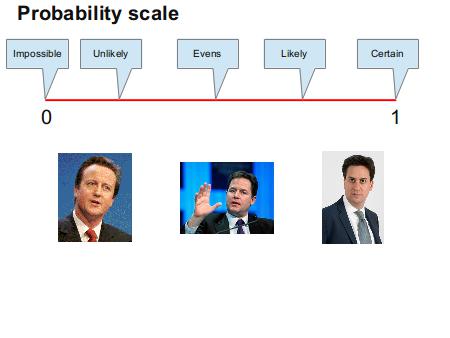
The slide above puts the likelihood words in order along the probability scale. The images of some of our political leaders are not in any specific order other than alphabetical. I asked students who these people where, most knew Mr Cameron but some did not recognise Mr Clegg or Mr Milliband straight away. Some hilarity in the answers to the question "who is most likely to be elected next time?".
I had put sticky notes out on each desk before the lesson. Each sticky note had a simple statement written on it, two copies of 12 statements (actually adapted from a Functional Skills teaching guide). Each student had to post their sticky note in one of the columns on the 'magic whiteboard' patches on the classroom wall. The front half of the class used one scale, and the back half used the other to save crowding around.
Right click and 'view image' on the thumbnails below to see the full sized images.
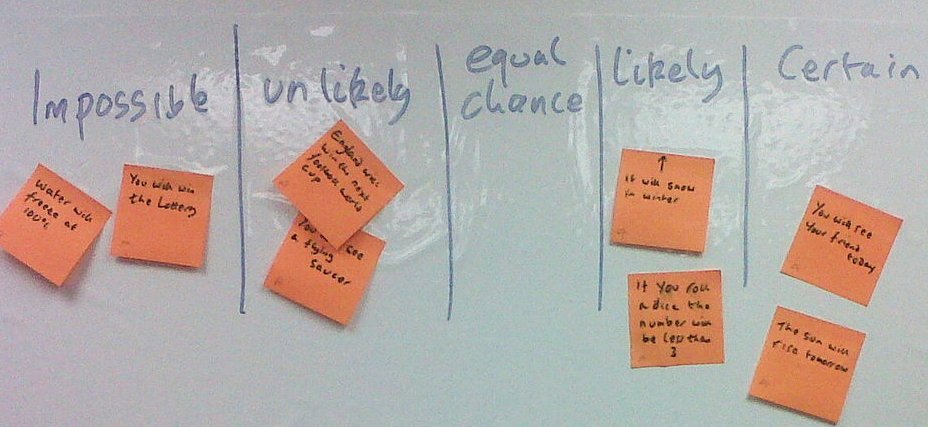
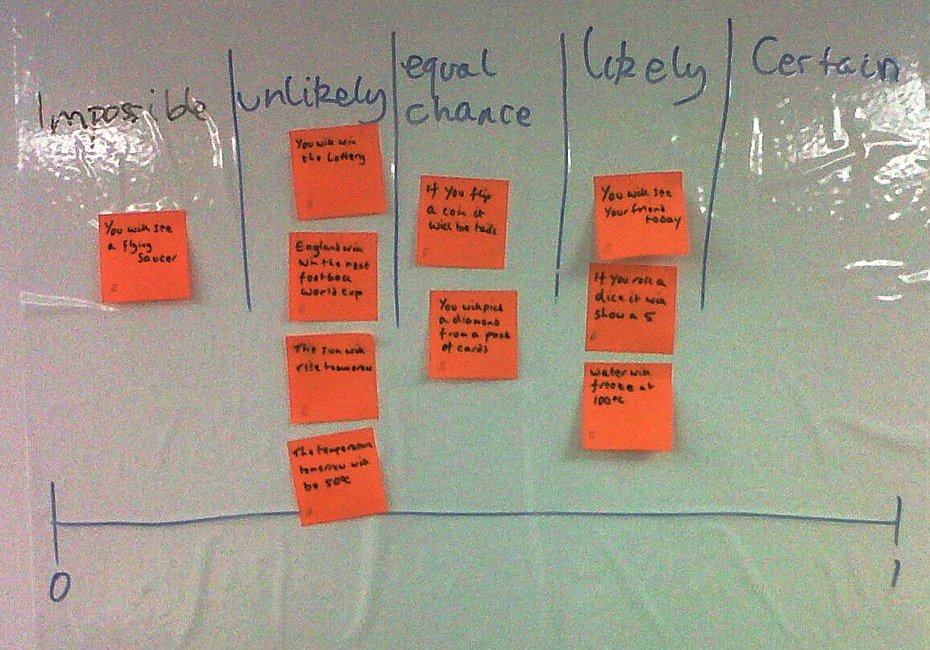
As you can see, some of the statements were misclassified. I just moved them to the right column and invited (other) students to explain why.
"If you roll a dice it will show a 5"
and
"If you roll a dice the number will be less than 3"
Both were classified as likely. I produced a die and showed that 5 was just a label for one side . The class got the point then, and all were able to classify the second statement correctly. In all our textbooks, the plural is used even for one die. There is always at least one student who knows the correct singular and plural so I get them to write it up, and point out the similarity with mouse and mice.
"Water will freeze at 100°C"
Impossible of course; most knew that and we went through the freezing and boiling points. And the reason we put salt on the roads when it is cold.
"The Sun will rise tomorrow"
Classified as unlikely. Quite a few people interpret sunrise as meaning the sun is shining, and it tends not to be at this time of year here. I encouraged other students to explain sunrise, sunset and the idea that the Sun is still behind any cloud you might see. This statement has been used in exam questions. I mentioned David Hume, but did not go into the details.
"You will pick a diamond from a pack of cards"
This statement was put in the evens column, but other students gave a run down on the standard 52 card pack. I always explain that playing cards are not used in exams but may crop up in textbook examples.
"You will see a flying saucer"
I forgot to bring my paper saucers to this lesson, but I have played that joke in the past. The students got one back on me with
"You will win the lottery"
I was saying that there was a small chance of someone winning, student who posted that sticky note pointed out that she does not play the lottery! Well done.
I think this activity helps to link the likelihood words with everyday things and other bits of general knowledge.
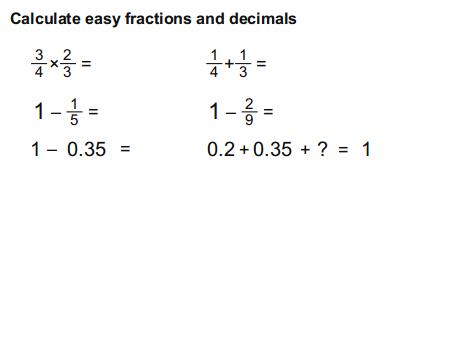
Back in the seats and a quick check on basic arithmetic needed for probability. The questions were done without calculators. 1 - 0.35 and similar sometimes cause trouble, I link those to money and getting change from a pound. Till receipts embody a lot of arithmetical concepts.
Then a worksheet with some easy questions taken from Foundation papers: labelling a scale broken into sixths, listing the combinations of tossing three coins, a two way table question. Students work through, I coach then we summarise on the whiteboard where I have screen grabs of the questions to write on.
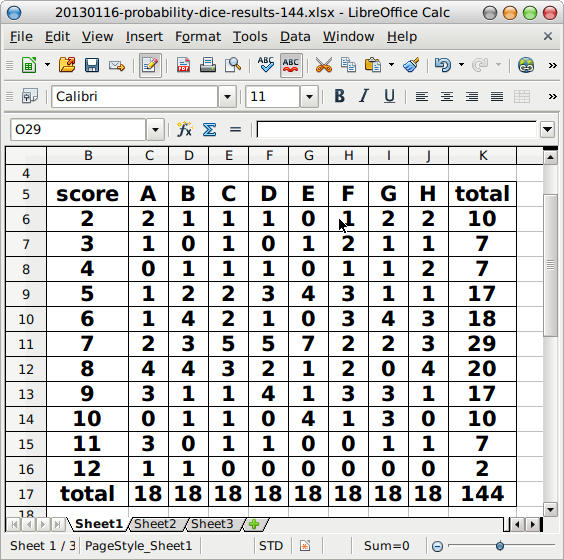
I always include some practical work in probability lessons; I've perfected my rolling two dice experiment using a template for recording results and tallying the scores. We used some plastic cups to ensure decent rolling this time. The nice set of results recorded above will be added to the rolling two dice page soon. I also devised a sample space diagram sheet for the second half of the lesson (which also covered mutually exclusive events and expected frequency).
The activity was quick to set up, and the lesson including practical work and collating results in a spreadsheet on the projector took just under the hour.
Keith Burnett, Last update: Sun Jan 20 2013